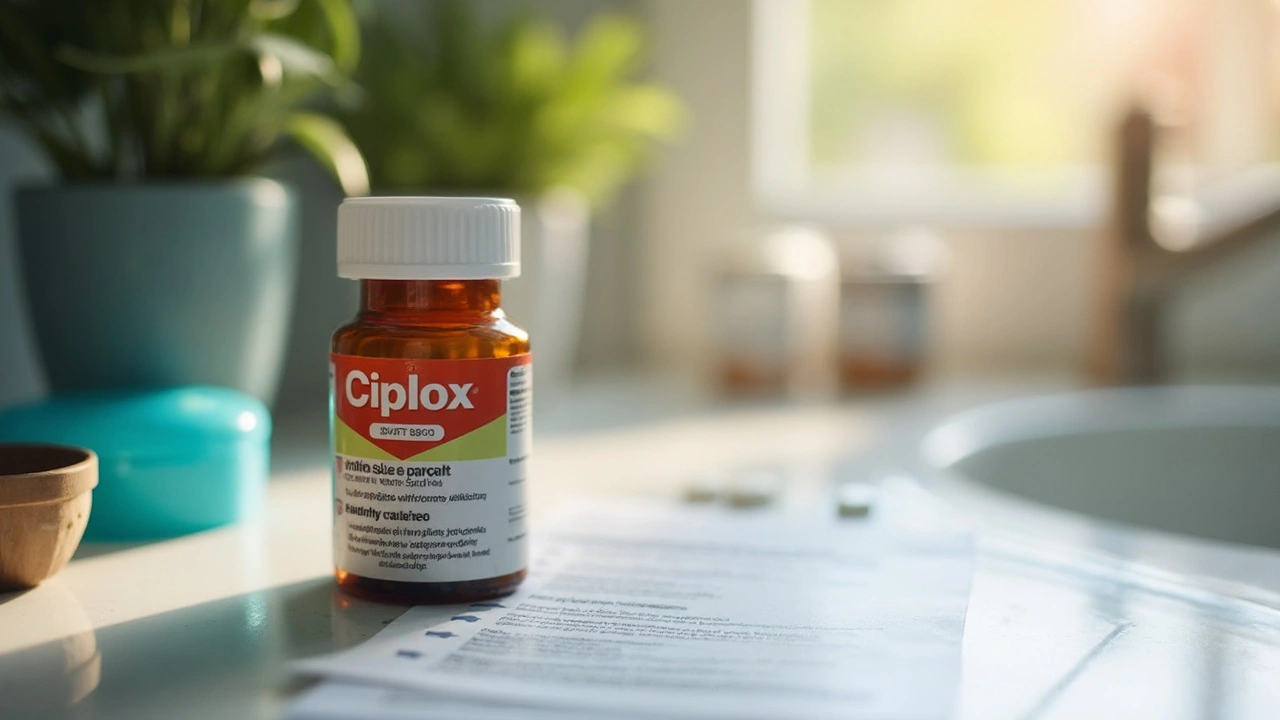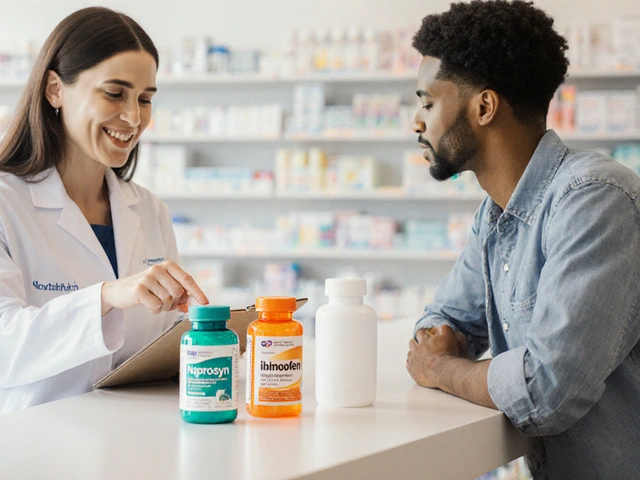Ask the average person about antibiotics, and chances are they've heard of amoxicillin. But bring up Ciplox, and you'll get mostly blank stares. Yet, this oddly named pill is a powerhouse in the world of infection treatment, and it's one that's landed in many medicine cabinets across the globe—though often not without drama. Picture this: you’ve just come back from a tropical vacation, only to wake up a week later feeling miserable with a sudden fever and pain when you pee. A trip to the doctor later, and there it is scrawled in chicken-scratch on the prescription pad—Ciplox. What exactly have you been given, and why? There are stories of amazing recoveries and also tales of stomach woes and rare reactions. Is this medicine friend or foe? Let’s get into the details so you handle Ciplox with less uncertainty.
What Is Ciplox and How Does It Work?
Ciplox is the brand name for ciprofloxacin, an antibiotic in the fluoroquinolone family. This drug was first introduced in the late 1980s and quickly caught the attention of doctors because of its ability to tackle a wide range of nasty bacteria. It works by interfering with the DNA replication process in bacteria, essentially stopping them from multiplying and causing havoc in your system. The action is kind of like removing a key part from an assembly line—you don’t have to smash the whole factory, you just halt production. That’s what makes fluoroquinolones, including Ciplox, so valuable for tough infections.
The conditions Ciplox is used for are mostly bacterial—not viral—so don’t expect it to help with colds or flu. Doctors commonly prescribe it for urinary tract infections (UTIs), certain types of pneumonia, vessel infections, and even some forms of gastroenteritis, especially when the culprit is a stubborn or resistant bug. Sometimes, Ciplox is used to treat bone infections, skin wounds that just won’t heal, or even severe traveler’s diarrhea. It’s a bit of a Swiss Army knife in medicine cabinets, but using it properly is key.
This drug is available in several forms: tablets, oral suspension, and even injections. The typical adult dose ranges from 250mg to 750mg twice daily, depending on the condition. If you’ve ever seen a pack of Ciplox, you probably noticed the directions about not mixing it with milk, not taking it on a full stomach, and keeping it out of reach of children. Those warnings are there for a reason—some foods and drinks (especially dairy products) can make the medicine less effective by reducing how much your body absorbs.
One thing that sets Ciplox apart from many other antibiotics is its ability to penetrate tissues deeply. That means it’s often a top pick when treating infections in the bones, joints, or the prostate. But that deep penetration comes with responsibility—overusing or misusing Ciplox can lead to bacteria developing resistance. Once bacteria get wise to this drug’s tricks, treatment options whittle down quickly. Doctors are careful with how and when they give it out.
Interestingly, Ciplox is sometimes used off-label for anthrax exposure. After the 2001 anthrax attacks, ciprofloxacin became a household name in some circles simply because it was distributed as part of emergency preparedness kits. This isn’t common practice, but it does point to just how broad its infection-fighting spectrum can be.
As one infectious disease specialist sums it up:
"Ciprofloxacin remains a go-to antibiotic for several hard-to-treat infections, but it’s not a cure-all. It’s powerful, which means using it smartly is more important than ever." — Dr. Ellie Worsham, infectious diseases consultant
Key Uses and Benefits of Ciplox
It’s the classic UTI that brings Ciplox into play most often. For people who seem to land in the doctor’s office with a one-way ticket to discomfort, Ciplox can provide relief in as little as 24 hours. This makes sense—its absorption rate is fast, and it starts fighting infection soon after you pop the first pill. But Ciplox isn’t only for bladder infections. Here’s a breakdown of its main uses:
- Urinary tract infections – This is the big one. Ciplox is often used when first-line drugs don’t work or aren’t an option due to allergies.
- Prostatitis – Men with infections in the prostate gland sometimes need a medicine that can reach deep tissue; Ciplox fits the bill.
- Pneumonia and bronchitis – Especially when the bacteria involved are not responding to more common antibiotics.
- Typhoid fever and certain types of gastroenteritis – Ciplox knocks down bacteria like Salmonella typhi, especially in regions where resistance to older drugs has become a problem.
- Bone and joint infections – When those parts get infected, doctors look for antibiotics that get in deep, and again, Ciplox qualifies.
- Skin and soft tissue infections – Diabetic wound care is one example, as these infections often involve multiple bacteria including some that resist standard penicillins.
- Serious stomach bugs (bacterial diarrhea) – Especially for travelers or people with weakened immune systems.
- Antrax exposure (off-label use) – Used as part of emergency protocols during exposure scares.
So, how do you actually benefit? The speed of symptom relief is a major plus. People often notice a reduction in burning, urgency, and discomfort in 24 to 48 hours after starting Ciplox. Also, the convenience factor is hard to beat—it usually requires just two tablets daily, and that fits schedules better than antibiotics needing to be taken every few hours.
Doctors also appreciate Ciplox for being effective against bugs that have shrugged off older, weaker antibiotics. This is crucial in places where antibiotic resistance is becoming a big-time health threat. Hospitals see fewer relapses when treatment is finished properly, and proper dosing can sometimes mean the difference between a swift recovery and weeks spent feeling lousy.
Still, there’s a catch—using Ciplox only when you really need it. Unlike some lighter antibiotics, which sometimes get prescribed just in case, Ciplox is reserved for when the benefits really outweigh the risks. It’s also not the top choice for children unless the infection is especially stubborn or dangerous, because of potential impacts on joint development.

Risks, Side Effects, and What To Watch Out For
Every medicine comes with a warning label, and Ciplox’s is hefty for a reason. The most common side effects are usually mild but annoying—think nausea, vomiting, stomach pain, or a feeling that your digestive system is a tad out of whack. I remember Fiona once complained about a metallic taste in her mouth and a bit of a sunburn after a short walk outside; both can happen, although she swears the beach trip was worth it.
A little less common are issues like headaches, sleep disruption, or diarrhea. While most people don’t get these, if you’re unlucky, it can cramp your style for a few days. Still, these are manageable and tend to fade when the course ends.
The things that really grab attention are the rare but serious side effects. There’s possible tendonitis and tendon rupture, especially in older adults or athletes who put a lot of strain on their bodies. There’s also a known risk of nerve problems (peripheral neuropathy), with symptoms like tingling or numbness that can linger. Some people report tremors, confusion, or even hallucinations—these are deal-breakers and should never be ignored.
Ciplox can increase your sensitivity to sunlight. This can sneak up on you—a quick afternoon outside that used to be fine might leave you with a neon-red patch that lasts for days. Wearing sunscreen and covering up is a must if you’re taking it during sunny months.
Here’s something a lot of people don’t expect—Ciplox can mess with your heart. In rare cases, it can prolong a specific electrical rhythm in your heart called the QT interval. If you have heart problems or are already on meds that affect heart rhythm, tell your doctor. And never mix Ciplox with antacids containing magnesium or aluminum right before or after you take a dose; they can block its absorption entirely.
Some folks can have allergic reactions, too. Rash, trouble breathing, or swelling are signs you need to seek help urgently. And if you have a history of seizures or brain issues, bring it up. Ciplox isn’t the first choice for people with epilepsy.
Doctors are aware of drug interactions to sidestep. Ciplox can raise the effects of caffeine and certain diabetes medicines, raising the risk for side effects. Always keep a list of what you’re taking and show it at every doctor visit.
For pregnant or breastfeeding women, Ciplox usually isn’t recommended unless there isn’t a safer alternative, since there are some concerns about its effects on developing joints and bones in the fetus or newborn.
If you finish a full course of Ciplox and still don’t feel back to yourself, follow up. Sometimes bacteria are resistant, or the original bug wasn’t quite what the doctor expected. Never just stop taking the medicine when you feel better—this is how resistance builds up, and it can make things much harder if you get sick again.
Tips for Safe and Effective Use of Ciplox
You want to squeeze the most benefit out of Ciplox without risk. First things first—take it exactly as prescribed. If your doctor says finish the pack, don’t save a few for a “rainy day.” Incomplete courses breed superbugs that don’t listen to Ciplox anymore.
Don’t mix Ciplox with dairy products (milk, cheese, yogurt, ice cream) around dosing. A glass of milk right before your tablet can drop absorption by as much as 40%. Space dairy snacks at least two hours before or after your dose. If you’re a morning cereal lover, switch to almond or oat milk for the temporary fix.
Keep hydrated. The medicine can stress your kidneys a little, so flushing it out with enough water helps reduce the strain. Aim for clear, light-colored urine as a basic indicator that you’re staying topped up.
Use alarms or a routine—like brushing your teeth—to remember each dose. Missing doses lets bacteria regroup and makes treatment less effective. If you do miss a pill, take it as soon as you remember, unless it’s almost time for the next dose. Never double up.
If you get any weird tendon pain, sudden swelling, severe diarrhea that doesn’t improve, or vision changes, don’t tough it out alone. Call your doctor immediately. Even if these symptoms seem to fade, they shouldn’t be ignored, as they might point to rare complications.
Most importantly, avoid driving if you get dizzy or have vision changes. While most people do fine, some get temporary side effects that make operating heavy machinery or cars unsafe.
Limit time in the sun. If you’re headed outside, put on protective clothing and plenty of sunscreen. This isn’t the moment for impromptu sunbathing, especially with Ciplox in your system.
Store the medicine somewhere cool and dry, away from sunlight and out of reach of curious kids. Tablets are generally good for years unopened, but always check the expiry date before starting a leftover pack. Signs of spoilage or weird smells mean it's time to toss them and get a fresh supply.
If you have any reason to doubt you’re taking Ciplox for the right bug, get a second opinion. With rising antibiotic resistance, precisely matching drug to bug makes all the difference. Never pressure your doctor into giving you antibiotics "just in case"—using them wisely is what keeps them effective for everyone.
And remember, antibiotics like Ciplox don’t work for viral infections like cold or flu. Taking them out of habit or hope does more harm than good.






Comments
OKORIE JOSEPH
22/Jun/2025Ciplox is a dangerous shortcut for any doctor who thinks they can cheat the system. Stop handing it out to anyone with a sore bladder.
Lucy Pittendreigh
22/Jun/2025Prescribing Ciplox for a simple UTI is just reckless. Doctors should think twice before popping a fluoroquinolone into a patient.
Nikita Warner
22/Jun/2025Ciprofloxacin, marketed under the brand name Ciplox, belongs to the fluoroquinolone class and exerts its antibacterial effect by inhibiting DNA gyrase and topoisomerase IV, enzymes essential for bacterial DNA replication. It is formally indicated for complicated urinary tract infections, certain forms of bacterial pneumonia, prostatitis, and bone or joint infections where deep tissue penetration is required. The standard adult dosing ranges from 250 mg to 750 mg administered twice daily, with adjustments necessary for renal impairment. Absorption may be reduced by divalent cations, hence co‑administration with calcium‑containing antacids or dairy products should be spaced at least two hours apart. Therapeutic drug monitoring is rarely needed, but clinicians should be vigilant for adverse events such as tendonitis, QT interval prolongation, and photosensitivity. In pregnant or lactating patients, the risk–benefit ratio must be carefully evaluated due to potential fetal skeletal toxicity. Resistance development is a growing concern; therefore, culture‑directed therapy is preferred whenever feasible.
Liam Mahoney
22/Jun/2025Look, using Ciplox without a proper culture is outright irsponsible. It’s not a magic bullet and you’re endangring patients.
surender kumar
22/Jun/2025Oh sure, everyone loves a drug that can turn your tendons into paper. If you’re into spontaneous tendon rupture, go ahead.
Justin Ornellas
22/Jun/2025While the article correctly notes that ciprofloxacin inhibits DNA gyrase, it repeatedly misplaces commas-an egregious oversight in a medical text. One might argue that language, like medicine, must obey precise rules; otherwise we risk eroding the very clarity that underpins patient safety. Moreover, the philosophical implication of a drug that can both save lives and cause irreversible tendon damage invites us to consider the ethical limits of human intervention. In other words, the more powerful the molecule, the greater our responsibility to wield it judiciously.
JOJO Yang
22/Jun/2025Ciplox may look like a savior but it’s a wolf in sheep’s clothing! If you think otherwise you’re deluding yourself.
Faith Leach
22/Jun/2025The pharma giants have teamed up with governments to push Ciplox as a catch‑all solution while hiding data on tendon failures. It’s a coordinated effort to keep us dependent on chemically engineered weapons masquerading as medicine. Don’t be fooled by the glossy brochures; the real agenda is profit and control.
Eric Appiah Tano
22/Jun/2025Stay hydrated, keep the dosage schedule consistent, and always finish the full course even if you feel better. If any unusual pain or skin reaction shows up, call your provider right away. Remember, antibiotics are a team effort between you and your clinician.
Jonathan Lindsey
22/Jun/2025Ah, the glorious world of Ciplox, where optimism meets the harsh reality of antimicrobial stewardship. One might begin with a gleeful belief that a two‑tablet daily regimen will vanquish any infection, only to discover the hidden choreography of resistance lurking beneath the surface. Yet, let us not be disheartened, for each completed course is a small victory against the invisible army of bacteria.
First, adherence to the prescribed schedule ensures that plasma concentrations remain above the minimum inhibitory concentration, preventing the selection of tolerant strains. Second, avoiding dairy and antacids around dosing maximizes absorption, a simple tweak with profound impact. Third, staying under the sun’s harsh glare while on therapy reduces the risk of photosensitivity-a reminder that even medications have environmental preferences.
In the grand tapestry of modern medicine, Ciplox is but a single thread, woven with care among many others. Its utility shines most brightly when reserved for truly resistant infections, not for every urinary ache that crosses our path. By reserving it for cases where first‑line agents falter, we preserve its potency for future generations.
Finally, remember that no pill is a panacea; lifestyle, nutrition, and hygiene are allies that work in concert with antibiotics. So, celebrate the moments when Ciplox works, but keep your eyes open to its limitations. In doing so, we honor both science and common sense.
Gary Giang
22/Jun/2025Spice up your regimen, but keep it safe.
steve wowiling
22/Jun/2025Life is a fleeting echo, and Ciplox is just another fleeting echo in the pharmacy aisles.
Warren Workman
22/Jun/2025From a pharmacokinetic standpoint, the Tmax of ciprofloxacin typically occurs within 1–2 hours post‑dose, and its volume of distribution approximates 2–3 L/kg, underscoring its extensive tissue penetration which justifies use in osteomyelitis and prostatitis despite the concomitant risk of tendon toxicity.
Kate Babasa
22/Jun/2025Indeed, Ciplox offers a broad spectrum of activity, yet clinicians must balance efficacy, safety, and the ever‑growing concern of resistance, especially when alternative agents are available, and therefore, judicious prescribing remains paramount, not merely a suggestion, but an ethical imperative.
king singh
22/Jun/2025I agree, let’s keep the conversation constructive.
Adam Martin
22/Jun/2025Isn’t it just delightful how every time we discuss Ciplox, someone manages to bring up the delightful topic of tendon rupture? It’s like the drug’s unofficial side‑effect party, and you’re always invited. But seriously, the literature does show a dose‑related increase in tendonitis, especially in patients over 60 or those on corticosteroids. If you’re an athlete, you might want to keep a spare pair of knees handy. Meanwhile, the drug’s ability to breach the blood‑brain barrier is a double‑edged sword-great for CNS infections, terrifying for off‑label misuse. So, enjoy the convenience of twice‑daily dosing, just remember the fine print: stay out of the sun, hydrate, and maybe keep a physio on speed‑dial.
Ryan Torres
22/Jun/2025Don’t trust the mainstream narrative-big pharma hides the true side‑effects of Ciplox, and they don’t want you to know 🕵️♂️. Keep your eyes open, question everything, and protect yourself 👀.
shashi Shekhar
22/Jun/2025Sure, let’s just ignore all the data and keep popping pills like candy-best health advice ever, right?
Marcia Bailey
22/Jun/2025Great points, everyone! 😊 Remember to read the label, stay hydrated, and call your doctor if anything feels off. You’ve got this! 🙌
Hannah Tran
22/Jun/2025While I appreciate the enthusiasm, let’s not forget that ciprofloxacin’s CYP450 interactions can lead to serious QT prolongation in patients with underlying arrhythmias-use with caution.